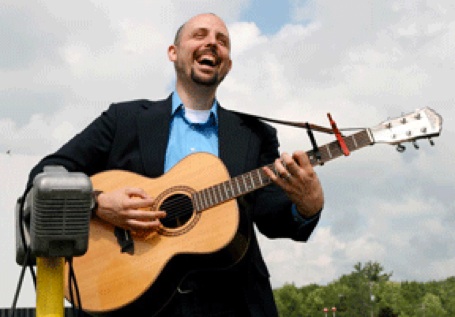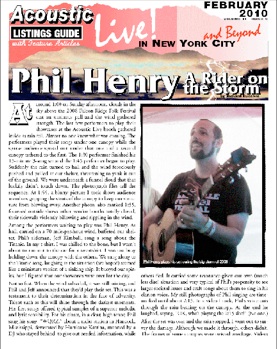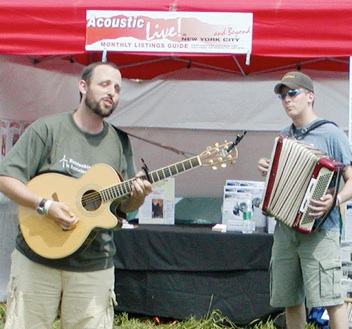Phil Henry
A Rider on the Storm
by Richard Cuccaro
At around 1:00 on Sunday afternoon, clouds in the sky above the 2008 Falcon Ridge Folk Festival cast an ominous pall and the wind gathered strength. The last few performers to play their showcases at the Acoustic Live booth gathered inside as rain fell. Almost no one knew what was coming. The performers played their songs under one canopy while the sparse audience spread out under that one and a second canopy tethered to the first. The 1:30 performer finished his 15-minute 3-song set and the 1:45 performer began to play. Suddenly the rain turned to hail and the wind ferociously pushed and pulled at our shelter, threatening to yank it out of the ground. We were underneath a funnel cloud that luckily didn’t touch down. The photograph files tell the sequence. At 1:55, a blurry picture I took shows audience members gripping the struts of the canopy to keep our structure from blowing away. Another photo, also marked 1:55, focussed outside shows other vendor booths totally closed, their sidewalls violently billowing and rippling in the wind.
Among the performers waiting to play was Phil Henry. As hail, carried on a 70 mile-per-hour wind, buffeted our shelter, Phil’s sideman, Jeff Kimball, sang a song about the Titanic. In my t-shirt, I was chilled to the bone, but I wasn’t about to run out to the car for a sweatshirt. I was too busy holding down the canopy with the others. We sang along to the Titanic song, laughing as the situation (we hoped) seemed like a miniature version of a sinking ship. It buoyed our spirits, but I figured that our showcases were over for the day.
Not so fast. When the wind subsided, it was still raining, and Phil and Jeff announced that they’d play their set. This was a testament to their determination in the face of adversity. Talent such as this will shine through the darkest moments. His first songs offered typical samples of a superior melodic and lyric sensibility. For his closer, in a clear, high tenor, Phil sang his song "WQRZ,” about a radio station in Hancock, Mississippi, devastated by Hurricane Katrina, manned by a DJ who stayed behind to give out needed information, while others fled. It carried some resonance given our own (much less dire) situation and very typical of Phil’s propensity to see larger societal issues and craft songs about them to sing in his clarion voice. My still photographs of Phil singing are time-marked until about 2:15. In a video I took, Phil’s voice cuts through the rain drumming on the canopy. At the end he laughed, saying, “Who’s on at 2:15?” (No one.)
Phil Henry plays his set during the big storm of 2008
After the set was over and the rain stopped, I went out to survey the damage. Although we made it through, others didn’t. The frames of some canopies were twisted wreckage. Videos posted later on Youtube showed showed the violence of the storm.
We’ve never forgotten Phil’s (and Jeff’s) buoyant spirit that day, coming hand-in-hand with his amazing voice and inspiring songs. Since 2005, he’s been a valued performer in every Falcon Ridge and NERFA showcase we’ve held. At each showcase he played for us, in addition to his stellar voice, we’d invariably hear a melody that seemed ready for radio airplay, a cut above our average showcase performer. Additionally, he’s been a steady Falcon Ridge staff volunteer. More often than not, his smiling face would be the first to greet us on day one, when we pulled into the parking lot at the festival, as he directed cars into the proper lane.
With the advent of his new album Robots and Romance (folkier than the title might suggest), it’s time to give the man his props.
Beginnings
Phil was born in 1975 in Saranack Lake, New York, a part of the Adirondack mountain region. He was creative as a child, engaging in visual arts, drawing and painting. Around 10-11 years of age he was singing in a summer program children’s choir. Renown jazz pianist Dave Brubeck visited and played a new piece of music he had written, with the choir accompanying him.
It made a big impression on Phil.
Phil sang in school choir from 3rd grade on and additionally, picked up trumpet study in the 6th grade. He played trumpet through high school in both the jazz and marching bands, thereby achieving full band geekdom (as opposed to the author, who achieved geek status while throwing spitballs in study hall). While a junior in high school, the guitar made its entrance. He began to try to keep up with friends who were in a rock band. He’d practice on an acoustic guitar at home but would play an electric when he jammed with his friends.
“I did as much music as I could,” he says.
The Budding Writer
He describes himself at that time as a “closet writer.” Phil decided that, if he couldn’t play songs on the radio, he’d write his own. The acoustic guitar he owned was a classical and definitely, in teen parlance, “not cool.” Also, when he began driving around this time (16-17 years old), there was one tape stuck in his parents’ car player: Simon and Garfunkel’s Bridge Over Troubled Water. This was a big inspiration. It “could’ve been worse, he says (I picture Lawrence Welk).
College
After high school, Phil attended college at SUNY in Potsdam, New York, up near the Canadian border. Crane School of Music, a part of SUNY at that location, is certified for Music Education, and that became Phil’s major. There was instrument training, enabling students to teach different instruments and weekly vocal lessons. Additionally, Phil sang in various choirs. Never a huge fan of classical music, Phil said he felt “out of place.” Nevertheless, Phil graduated with a degree in Music Education in 1997.
After graduation, he taught chorus and a “general music class” at a middle school in Ticonderoga, New York. While there, he’d drive one-and-one-half hours each way once a week to play the open mics at Caffe Lena, in Saratoga. There, he got to see other singer/songwriters and absorb other influences.
Settling in Vermont
In 2003, he got a job teaching in West Rutland, Vermont, at West Rutland School, where he still teaches today
Back in New York someone had given him a tape by Martin Sexton, and later, in Burlington Vermont, he caught one of Martin’s live shows. This was an important turning point. In Martin, he saw “folk music with a rock attitude.” After this, he began writing in earnest. He spent time alone, “woodshedding.” Phil recorded each song he wrote into a tape recorder. When he felt he had enough songs of decent quality, he had a CD made. Then, he started doing gigs.
Phil and Jeff doing a showcase set at our booth under
sunnier conditions at the 2007 Falcon Ridge Folk Festival
Another watershed moment came in 1998, when he first attended Falcon Ridge Folk Festival. His impression of the folk community there was, “loud, big, and energetic.” After attending other festivals, he believes, at Falcon Ridge the energy is stronger and faster-paced than at other festivals.”
In 2000, Phil published his first commercial-quality CD, Board by Board. In 2005, he was selected as one of the 25 “Emerging Artists” at Falcon Ridge, picked to play two songs at the Friday afternoon showcase. That year, he also attended his first Northeast Folk Alliance (NERFA) Conference. Helping to represent him at the conference was his second CD, No Place Like Here. Phil came to my attention that year, as someone to watch, after he asked to play a showcase slot at the Acoustic Live booth at Falcon Ridge. His clear, sharp vocals and catchy melodies won me over instantly. Phil has played at every one of the Acoustic Live Falcon Ridge and NERFA guerilla showcases ever since.
In 2008, after submitting a CD, Phil was accepted as a Kerrville New Folk Finalist Thus, furthering his singer/songwriter education, he made the pilgrimage to the yearly “mecca” of all singer/songwriters, the Kerrville Folk Festival, in Kerrville, Texas. Around the campfires, into the wee hours of the morning, he soaked up the songs of players, many with hundreds more miles on their tire treads.
Robots and Romance

In recent years, Phil recorded two EPs, before recording his 2010 CD, Robots and Romance. While the themes deal with contemporary issues, they’re expressed with the traditional tools of acoustic guitar, banjo and mandolin.
The album title refers to the cinematically-influenced themes in many of the songs. The opening track, “Drive-in”(and cover art) is a call to remember the pleasures of a now-disappeared form of recreation. “Where were you when the martians came -- mind control and laser rays?” he sings, and then recalls films such as High Noon and Creature from the Black Lagoon.
The lyrics to “Open Range,” one of the favorites for this author, contain the album title. Decrying the loss of the old western movie, the narrator says, “Farewell to the silver screen cowboy, it’s all robots and romance at the movies these days.” In a secondary sub-theme, the narrator, speculating about a sterile hospital death, wants to die like a gunslinger, mortally wounded in a field: “I hope my horse goes runnin’ when he finds me on the ground … I was not born to die in a hospital bed. Or a crash in a rented DeVille.” The central figure tells the listener to look for his demise in an old cowboy film on TV during a couch-potato Saturday afternoon. He finishes with, “I thought I’d follow in the gunslinger’s path, but they’re all in some Hollywood grave. So when I go, I wanna go, out on an open range.”
No mere navel-gazer, Phil shows on this CD that he can generate stories “from the ground up,” using outside stimuli. After a robbery occurred a few blocks from where he lives, he wrote “Hold Up” from the viewpoint of a desperate man needing to care for a sick wife. Phil had noticed that the photo in the newspaper looked a lot like him (his co-workers did also, generating a lot of teasing). From there, he leapt into the mind of a grand larcenist.
“Up and Gone,” the song Phil wrote in tribute to his wife Alison, an avid hiker, is another of the author’s favorites. Over an intoxicating melody, he sings, “She’s up and gone, before the dawn and tiptoes like the light across my floor. She folds the map and slips it back into the bag that’s waiting by the door. She’s Gone. She’s up and gone.”
The album is filled with imagination and insight. Another fascinating song-profile is “Annie Hold On,” an ode to photographer Annie Liebovitz. Almost a doo-wop number, it’s done a capella in harmony with hand claps as the only accompaniment. It’s actually a cautionary tale: “Did you think you were in
control with John and Yoko and Rolling stone? Don’t you know it’s still a great big world, and Annie the frame’s so small. Hold, on, hold on. Take this moment in your stride. Flashes bright in black and white, but tonight, Annie hold on.”
While Phil continues to follow a career as a performer, he is also very proud of the job he does as a teacher in the Vermont school system, instilling the love of music in his students. He has created a program to enhance performance skills. As he states: “One big thing that I offer my students that many schools don’t is that we put on a coffeehouse concert twice a year with my Middle School and High School chorus students. They get experience choosing a song, rehearsing it with guitar or piano players, using microphones, talking to an audience … These are skills I didn’t learn until I was out of college, and ones that I use all the time. In addition, many of my students are beginning songwriters, and I can lend some information and guidance in that way.”
We’re guessing that Phil’s innovative approach continues to pay dividends in helping him to build on his already-considerable performance talents. We encourage our readers to see Phil in “live in concert” to enjoy those gifts.
Website: www.philhenryband.com
CD Release Concert:
Mar 20 8pm Caffe Lena, Saratoga Springs, NY


